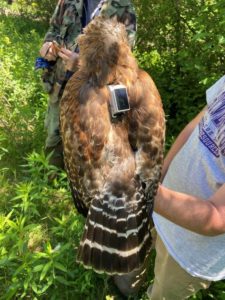 As I write I am looking out a large window at home. Outside the apple tree is in bloom, the ground is covered with green new growth, including my lawn which will be knee-high if I make it through “No Mow May”! Trees I’ve planted in the last five years are now 8-10 feet tall and sporting new leaves. A robin is already feeding nestlings in the juniper tree. And the black flies have returned.
As I write I am looking out a large window at home. Outside the apple tree is in bloom, the ground is covered with green new growth, including my lawn which will be knee-high if I make it through “No Mow May”! Trees I’ve planted in the last five years are now 8-10 feet tall and sporting new leaves. A robin is already feeding nestlings in the juniper tree. And the black flies have returned.Birds are everywhere. Each morning is an adventure, with some time spent before work identifying last night migrants, now singing, feeding, and resting before they continue their seasonal journey. Orioles, grosbeaks, and warblers dance in the trees. It reminds me of a quote from a Garrison Keillor book “Thank you Lord for this good life, and forgive us if we don’t love it enough.”
At Woodland Dunes, a very special visitor returned from winter vacation. A red-shouldered hawk, a threatened species. For many years I heard red-shouldereds at the preserve, and suspected they nest there, but I did not know where back in the hundreds of acres of swamp forest. Last year. while planting trees, our interns found the nest. We contacted an expert on those hawks, who came up, caught, and banded the female. He also place a UHF recorder/transmitter in a tiny, solar powered backpack that was placed on the bird. Then she was release to raise her three youngsters. She is a strong, aggressive female very capable of defending her nest.
The next month the researcher returned and recorded hundreds of points within our preserve that our hawk had visited, probably feeding herself and the young. Then, in fall, she left and was not heard from.
This spring, a pair of hawks came back to the nest, but when we listened we found it was not the same female- she was an untagged youngster. She used the same nest, and presumably laid eggs, as we saw her sitting quitely, probably incubating them. A month later, however, the nest was checked again, and the original female was back! Data was downloaded, and we found that she made her way to Alabama where she spent three months in winter, then journeyed back north, using a route west of her southward trip. She went to central Wisconsin, over to Green Bay, then back down to Woodland Dunes. She apparently evicted the young female, and now site on the nest herself.
Because a fisher was seen in the area, and they are know to predate hawk nests among other things, we went back and installed a smooth predator guard around the tree, which another hawk expert donated. We will put up a trail camera to find out what tries to climb the tree.
In another few weeks our expert friend will visit again to download more data and check condition of the nest. Feathers fallen to the ground will be collected, as they were last year, for DNA analysis. From year to year we should be able track the birds and tell if they are the same or descendents of the original pair. We hope they are successful, as there are relatively few of these birds in the State. And managing our preserve to benefit wildlife, and the community, is our mission. Events like this are especially rewarding for our staff, and underline the importance of our preserve. They are what keep us motivated!
photo- Red-shouldered hawk with backpack transmitter, by Carter Freymiller, Natural Resources Foundation of Wisconsin
